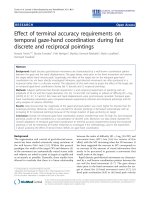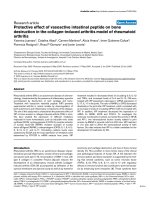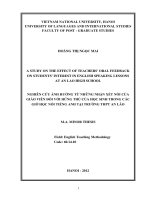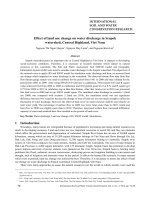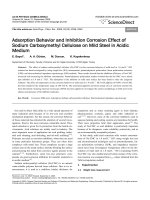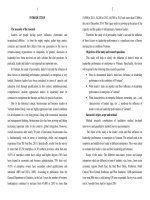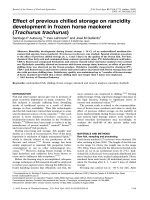The effect of single embryo transfer on perinatal outcomes in Japan
Bạn đang xem bản rút gọn của tài liệu. Xem và tải ngay bản đầy đủ của tài liệu tại đây (327.79 KB, 6 trang )
Int. J. Med. Sci. 2015, Vol. 12
Ivyspring
International Publisher
57
International Journal of Medical Sciences
2015; 12(1): 57-62. doi: 10.7150/ijms.10352
Research Paper
The Effect of Single Embryo Transfer on Perinatal
Outcomes in Japan
Masako Hayashi1, Shoji Satoh2, Yoshio Matsuda3, Akihito Nakai1
1.
2.
3.
Department of Obstetrics and Gynecology, Nippon Medical School, Tokyo, Japan;
Maternal and Perinatal Care Center, Oita Prefectural Hospital, Oita, Japan;
Department of Obstetrics and Gynecology, International University of Health and Welfare, Tochigi, Japan.
Corresponding author: Masako Hayashi Ph.D. Tama-Nagayama Hospital, Nippon Medical School, 1-7-1 Nagayama, Tama-City, Tokyo
206-8512, Japan. Tel: 81-(0) 42-371-21 11 Fax: 81-(0) 42-372-73 72 E-mail:
© Ivyspring International Publisher. This is an open-access article distributed under the terms of the Creative Commons License ( />licenses/by-nc-nd/3.0/). Reproduction is permitted for personal, noncommercial use, provided that the article is in whole, unmodified, and properly cited.
Received: 2014.08.17; Accepted: 2014.11.04; Published: 2015.01.01
Abstract
Objective: In 2007 and 2008, the Japan Society for Reproductive Medicine and the Japan Society of
Obstetrics and Gynecology issued a recommendation for single embryo transfer (SET). Thereafter, SET was implemented in 73% of in vitro fertilization (IVF) cases in Japan. The purpose of this
study was to evaluate the effects of compliance with the SET recommendation on perinatal
outcomes.
Methods: An electronic audit of the perinatal database of the Japanese Society of Obstetrics and
Gynecology was conducted from 2001 through 2010. The database comprised data of 610,726
women. Totally, 20,923 women conceived through IVF. To compare perinatal outcomes, these
women were categorized into two study groups depending on whether they conceived before
(2004–2005, n = 3,865) or after (2009–2010, n = 6,842) the SET recommendation statement was
issued.
Results: The proportion of women who conceived through IVF increased from 1.3% in 2001 to
4.8% in 2010. Compliance with the SET recommendation led to a decrease in the incidence of twin
pregnancies (33.9% versus 13%, p < 0.01), incidence of preterm delivery (odds ratio [OR]: 0.54,
95% confidence interval [CI]: 0.50–0.59), low birth weight (OR: 0.42, 95% CI: 0.39–0.45), and
neonatal intensive care unit admission (OR 0.70, 95% CI 0.65–0.76), but an increase in the incidence of monochorionic twins (1.6% versus 2.5%, p < 0.01).
Conclusion: Compliance with the SET recommendation improved perinatal outcomes by reducing
the incidence of twin pregnancies.
Key words: in vitro fertilization, twin pregnancy, monochorionic twin, obstetric outcome, perinatal outcome.
Introduction
Since the birth of the first baby conceived
through in vitro fertilization (IVF) in 1978, assisted
reproductive technology (ART) has been a highly
successful and widely employed modality for treating
infertility. Initially, because inadequate embryo culture techniques resulted in a poor success rate following IVF, clinicians transferred multiple embryos to
maximize the chances of conception. As advances in
culture techniques improved the pregnancy rate of
IVF, multiple-gestation pregnancies increasingly became a problem (1, 2).
Recently, elective single embryo transfer (eSET)
has been adopted by ART centers worldwide as a
means to reduce the multiple pregnancy rates (3, 4). In
European countries, national legislation restricts the
number of embryos transferred (3, 5). In 1998, the
American Society for Reproductive Medicine issued
practice guidelines on the number of embryos to
Int. J. Med. Sci. 2015, Vol. 12
transfer, and has periodically revised these guidelines, most recently in 2013 (4). These guidelines
recommend consideration of eSET in women with a
favorable prognosis aged under 35. Single-embryo
transfer (SET) has been slowly adopted in many
countries, and a few studies have assessed the contribution of the eSET strategy on perinatal outcomes
(6-8).
In Japan, the Japan Society for Reproductive
Medicine (JSRM), concerned about the number of
multiple births resulting from ART, prepared concrete
recommendation regarding the number of embryos
transferred in 2006, and developed specific guidelines
about the number of embryos to be transferred in
March 2007(9, 10). In 2008, the Japan Society of Obstetrics and Gynecology (JSOG) issued a recommendation for SET for all cases except in cases of repeated
IVF failure or in patients >35 years where two embryos could be transferred (11).
This study evaluates the effect of compliance
with the SET recommendation on perinatal outcomes
in pregnancies conceived through IVF using a large
Japanese database.
Materials and Methods
The study protocol was reviewed and approved
by the Institutional Review Board of Nippon Medical
School, Tokyo, Japan. We selected a case-control design to evaluate the effect of the SET recommendation
statement on the perinatal outcomes of pregnancies
conceived through IVF.
Data in this study derived from the perinatal
database of JSOG. This nationwide registry was established in 1974. Detailed descriptions of the database have been published previously (12, 13). In brief,
the attending physicians at 139 tertiary centers of the
Perinatal Research Network in Japan collected data
annually on all pregnant women in an offline clinical
database with a common format. The data were sent
to the perinatal committee of JSOG, where quality
control for the database was assessed.
We used data of 638,268 deliveries reported between 2001 and 2010. Gestational age was determined
on the basis of menstrual history, prenatal examination, and ultrasound findings, such as gestational sac
diameter, crown–rump length, and biparietal diameter. Linked data included information on maternal
characteristics, such as maternal age, parity, cigarette
smoking, and alcohol consumption during pregnancy, history of treatment for infertility (ovulation stimulation, intrauterine insemination, or IVF-embryo
transfer), medical complications, and pregnancy
complications. Fetal and infant outcomes were also
58
routinely recorded by attendants at delivery. These
data conform to uniform coding specifications, have
passed a rigorous quality check, and have been edited
and reviewed. The current study limited the analysis
to women who delivered a live birth or stillbirth at 22
weeks of gestation or more. After excluding missing
data, 610,719 pregnancies were included in this study.
Two study groups were created according to
whether they conceived before or after the SET recommendation statement was issued. We did not
adopt the data from 2006 through 2008 to exclude
influence of the shift period, because the guidelines on
JSRM were announced for one year before 2007 by
their journal and website, and JSOG issued a statement of recommendation for SET in 2008. The IVF
group included both women who received eggs
spontaneously fertilized by sperm in vitro, or eggs
fertilized by intracytoplasmic sperm injection (ICSI),
followed by transfer of the embryo back into the
uterine cavity. However, further information on the
use of ICSI was unavailable in our database.
Data were analyzed using SPSS Statistics version
17.0 (SPSS Inc., Chicago, IL, USA) and Excel (Microsoft, Redmond, WA, USA). Statistical analysis was
performed using the Mann–Whitney U test for continuous variables, such as maternal age, body mass
index (BMI), birth weight, and the chi-squared test for
categorical variables. A p value of <0.05 was considered statistically significant. Logistic regression analysis was used to compare adjusted odds ratios (OR)
and 95% confidence intervals (CI) for adverse obstetric and perinatal outcomes before and after the issue
of the SET recommendation.
Results
In total, 20,923 (3.4%) women conceived through
IVF during the study period. The proportion of
women who conceived through IVF increased dramatically from 1.3% in 2001 to 4.8% in 2010 (Figure 1).
From 2001–2006, the incidence of twin pregnancies
conceived through IVF increased concurrently with
the proportion of women who conceived through IVF.
After the issue of the SET recommendation statement
in 2007 and 2008, although a marked increase in the
proportion of pregnancies conceived through IVF was
evident, the incidence of twin pregnancies conceived
through IVF significantly decreased (Figure 1). The
incidence of twin pregnancies among the pregnancies
conceived with IVF was significantly decreased from
33% to 13% due to a reduction of dichorionic twins. In
contrast, the incidence of monochorionic twins conceived through IVF continuously increased between
2001 and 2010, from 1.1% to 2.6% (Figure 2).
Int. J. Med. Sci. 2015, Vol. 12
59
Figure 1. Changes in incidence of the pregnancies conceived with IVF and twin pregnancies after IVF treatment among the total pregnancy.
Pregnancies from IVF increased dramatically from 1.3% in 2001 to 4.8% in 2010. Twin pregnancies conceived through IVF increased concurrently with the proportion
of women who conceived through IVF, but after the SET recommendation statement was issued in 2007 and 2008, the incidence of twin pregnancies conceived
through IVF significantly decreased.
Figure 2. Changes in incidence of twin pregnancies conceived with IVF. The incidence of twin pregnancies among the pregnancies conceived with IVF was
significantly decreased from 33% to 13% with the reduction of dichorionic twins. In contrast, the incidence of monochorionic twins conceived through IVF continuously increased between 2001 and 2010, from 1.1% to 2.6%.
To evaluate the effect of compliance with the SET
recommendation on the perinatal outcomes of pregnancies conceived through IVF, women who conceived through IVF were categorized into two study
groups depending on whether they conceived before
(2004–2005, n = 3,865) or after (2009–2010, n = 6,842)
the SET recommendation statement issued. The maternal characteristics of the two study groups are
summarized in Table 1. Maternal age and the proportion of women with preexisting medical complications tended to be higher in 2009–2010 than in
2004–2005. The proportion of nulliparous women decreased in 2009–2010. No significant differences were
observed in BMI and alcohol consumption between
the two groups.
The overall incidences of obstetric and perinatal
complications in the study population are shown in
Table 2. The incidence of multiple pregnancies dras-
tically declined after the issue of the SET recommendation (twins: 33% versus 13%; triplets: 2.1% versus
0.3%; p < 0.01). However, the incidence of monochorionic twins was significantly higher in 2009–2010
(2.5%) than in 2004–2005 (1.6%; OR 1.54, 95% CI
1.15–2.07). The incidence of cesarean section decreased after the SET recommendation was issued
(OR 0.71, 95% CI 0.66–0.77). Marked decreases in the
incidences of threatened miscarriage (OR 0.52, 95% CI
0.44–0.62), preterm labor (OR 0.51, 95% CI 0.47–0.56),
and preterm delivery at <37 weeks (OR 0.54, 95% CI
0.50–0.59) and at <34 weeks (OR 0.61, 95% CI
0.54–0.69) were also evident in 2009–2010.
Delivery of low-birth weight infants (<2,500 g)
was common among women who conceived through
IVF. In 2004–2005, over a half of newborns were
low-birth weight infants. Compared with the
2004–2005 group, the incidences of low-, very low-,
Int. J. Med. Sci. 2015, Vol. 12
60
and extremely low-birth weight infants significantly
decreased in 2009–2010, at 52.3% versus 31.5%, 9.4%
versus 6.5%, and 3.9% versus 2.9%, respectively. The
incidence of small-for-gestational-age infants also
decreased in 2009–2010 (OR 0.55, 95% CI 0.48–0.63).
Compliance with the SET recommendation was associated with a decrease in adverse neonatal outcomes,
such as neonatal intensive care unit (NICU) admission
(OR 0.70, 95% CI 0.65–0.76), and infant death (OR 0.71,
95% CI 0.55–0.93).
Table 1. Maternal characteristics of the study population.
Maternal age (y)*
-34
35 – 39
40unclear / missed
Parity
Nulliparous
Multiparous
Unclear / missed
Body mass index*
-18.4
18.5 - 24.9
25.0 - 29.9
30.0unclear / missed
Smoking in pregnancy
Yes
No
unclear/missed
Alcohol consumption in pregnancy
Yes
No
unclear/missed
Preexisting medical complications
Yes
No
Diabetes mellitus
Yes
No
Hypertension
Yes
No
Thyroid disease
Yes
No
2004 – 2005
n = 3865
35 (19 - 54)
1743 (45.3)
1566 (40.7)
536 (13.9)
20
2009 - 2010
n = 6842
37 (21 - 58)
2075 (30.3)
3234 (47.3)
1531 (22.4)
2
3201 (82.9)
662 (17.1)
2
20.5 (14.6 - 40.7)
< 0.01
228 (15.5)
1096 (74.5)
113 (7.7)
35 (2.4)
2393
5228 (76.5)
1607 (23.5)
7
20.5 (11.9 50.2)
933 (16.0)
4273 (73.4)
472 (8.1)
140 (2.4)
1024
79 (2.3)
3356 (97.7)
430
64 (1.0)
6515 (99.0)
263
< 0.01
84 (2.5)
3293 (97.5)
488
165 (2.5)
6351 (97.5)
326
0.89
1209 (31.3)
2656 (68.7)
2749 (40.2)
4093 (59.8)
< 0.01
89 (2.3)
3775 (97.7)
219 (3.2)
6623 (96.8)
< 0.01
21 (0.5)
3844 (99.5)
80 (1.2)
6762 (98.8)
< 0.01
80 (2.1)
3785 (97.9)
307 (4.5)
6535 (95.5)
< 0.01
P
< 0.01
< 0.01
0.39
0.88
Values are %. * median (range). NA: not applicable.
Discussion
Our data show that compliance with the SET
recommendation successfully reduced multiple
pregnancies conceived through IVF and dramatically
reduced multiple pregnancy-related complications.
The proportion of pregnancies conceived
through IVF has rapidly increased in Japan. Until
2007, the incidence of twin pregnancies conceived
through IVF increased pari passu with the rate of
pregnancies conceived through IVF (Figure 1). Previous studies (14, 15) have suggested that multiple
pregnancies are the most serious complication of IVF
for both mother and child. The main risk factor of
ART treatment for dizygotic twinning and high-order
multiple pregnancies is the transfer of more than one
embryo (16, 17). It is established that multiple gestations carry a high risk of perinatal morbidity and
mortality and are associated with increased risk of
miscarriage, preterm delivery, and cesarean section
compared with singleton pregnancies (14, 18, 19).
SET has been gradually accepted worldwide as a
means to reduce multiple pregnancy rates (5). Recently, several studies (6, 20-24) have reported the
efficacy of SET, which yields an excellent pregnancy
rate and drastically decreases twin pregnancies. Other
retrospective studies (25, 26) have demonstrated that
SET after transfer of thawed embryos results in similar pregnancy rates as double-embryo transfer and
significantly decreased multiple pregnancy rates.
However, the number of SETs performed remains
modest in many countries. In the US, only 13.5% of
ART cycles employed SET in 2009 (27) and even in
Europe, only 22% of transfers were SET in 2008 (3).
Conversely, in Japan, the proportion of SET among
IVF cycles was high: 50% in 2007, 63.6% in 2008, 70.6%
in 2009, and 73% in 2010(28) although there was no
contract punitive clause for non-observance.
Our results indicate that the incidence of multiple pregnancies drastically declined after the SET
recommendation statement was issued. Simultaneous
to the reduction in multiple pregnancies, reductions
in the incidences of neonatal resuscitation, neonatal
NICU admission, preterm delivery, and cesarean section were evident. These results suggest that a higher
ratio of SET among IVF cycles in other countries, as
Japan, could have profound public health implications by reducing the occurrence of iatrogenic twin
pregnancies.
On the other hand, despite the reduction in twin
pregnancies, we found that the incidence of monochorionic twins conceived through IVF increased
from 1.6% in 2004–2005 to 2.5% in 2009–2010. To date,
several possible explanations have been proposed for
this increase in monochorionic twinning. Several authors have speculated that extended culture and/or
an increase in the use of ICSI to improve the pregnancy rate could contribute to the increased incidence
of monozygotic twins (29-32). Some studies (29, 30)
have concluded that the risk of monozygotic twinning
is increased when culture is extended to the blastocyst
stage. Another report (31) suggested that the risk of
monozygotic twinning may relate to the composition
of culture medium. A further report (32) found no
Int. J. Med. Sci. 2015, Vol. 12
61
association between the type of culture medium and
the risk of monozygotic twinning, although there was
a 24-fold increased risk of monozygotic twinning in
cycles involving both ICSI and extended culture. We
acknowledge that our results cannot support any of
these possibilities: the inability to identify fresh, frozen–thawed, cleavage-stage embryo transfer, blastocyst transfer, or ICSI cycles is a limitation of our database.
In conclusion, this study indicates that compliance with the SET recommendation improved peri-
natal outcomes through a reduction in multiple gestation rates. These results suggest than a higher proportion of SET among IVF cycles in other countries as
in Japan, could have profound public health implications by reducing the occurrence of iatrogenic twin
pregnancies.
Our results also demonstrate that the incidence
of monochorionic twins increased with the increased
compliance with the SET recommendation, which
requires further study.
Table 2. Comparison of perinatal outcome before (2004-2005, n=3865) and after (2009-2010, n=6842) the SET recommendation
statement issued.
Outcome
Pregnancies
Singleton
Twin
Monochorionic twin
Dichorionic twin
Unclear
Triplet
Type of delivery
Spontaneous cephalic
Instrumental
Cesarean
Others
Threatened miscarriage
Preterm labor
PIH
Placenta previa
Placenta accreta
Postpartum hemorrhage
Preterm delivery <37w
Preterm delivery <34w
blood loss during delivery (g*)
Maternal death
Infants
Birthweight (g*)
< 2500g
< 1500g
< 1000g
SGA
UmApH <7.0
Apgar score (5min) <7
Neonatal resuscitation
NICU admission
Infant death
Mother
Infant
2004 - 2005 year
n = 3865
n = 5340
2009 - 2010 year
n = 6842
n = 7780
2472 (64.0)
1311 (33.9)
62 (1.6)
1246 (32.2)
3
82 (2.1)
5927 (86.6)
892 (13.0)
168 (2.5)
719 (10.5)
5
23 (0.3)
< 0.01
< 0.01
< 0.01
< 0.01
3.65 (3.32 - 4.02)
0.29 (0.27 - 0.32)
1.54 (1.15 - 2.07)
0.25 (0.22 - 0.27)
< 0.01
0.16 (0.10 - 0.25)
1338 (34.6)
285 (7.4)
2220 (57.4)
22 (0.6)
281 (7.3)
1269 (33.0)
212 (5.5)
119 (3.1)
29 (0.8)
207 (5.4)
1271 (32.9)
483 (12.5)
747 (2-5448)
0 (0.0)
2798 (40.9)
634 (9.3)
3345 (48.9)
65 (1.0)
269 (3.9)
1374 (20.1)
384 (5.6)
243 (3.6)
95 (1.4)
443 (6.5)
1436 (21.0)
547 (8.0)
716 (7 - 6000)
2 (0.0)
< 0.01
< 0.01
< 0.01
0.04
< 0.01
< 0.01
0.78
0.2
< 0.01
0.02
< 0.01
< 0.01
0.03
0.54
1.31 (1.20 - 1.42)
1.28 (1.11 - 1.48)
0.71 (0.66 - 0.77)
1.68 (1.03 - 2.72)
0.52 (0.44 - 0.62)
0.51 (0.47 - 0.56)
1.02 (0.86 - 1.22)
1.16 (0.93 - 1.45)
1.86 (1.23 - 2.83)
1.22 (1.03 - 1.45)
0.54 (0.50 - 0.59)
0.61 (0.54 - 0.69)
2459 (252 - 4910)
2783 (52.3)
502 (9.4)
205 (3.9)
534 (10.0)
13 (0.5)
229 (4.3)
2071 (39.3)
1460 (27.3)
112 (2.1)
2800 (50 - 4790)
2440 (31.5)
504 (6.5)
221 (2.9)
447 (5.7)
40 (0.7)
278 (3.6)
2205 (28.6)
1628 (20.9)
117 (1.5)
<0.01
<0.01
<0.01
<0.01
<0.01
0.34
0.04
<0.01
<0.01
0.01
OR (95%CI)
NA
0.42 (0.39 - 0.45)
0.67 (0.59 - 0.76)
0.73 (0.60 - 0.89)
0.55 (0.48 - 0.63)
1.36 (0.72 - 2.54)
0.83 (0.69 - 0.99)
0.62 (0.58 - 0.67)
0.70 (0.65 - 0.76)
0.71 (0.55 - 0.93)
Values are n (%). * median (range). NA: not applicable.
Acknowledgments
We sincerely thank Mr. Norio Sugimoto for his
help to our statistical analysis. We also thank Professor Yukihiro Terada for valuable advice with regard
to interpretation of the results.
Contributions
1) Conception and design: M.H., A.N.,
2) Acquisition of data: S.S., Y.M.
3) Analysis and interpretation of data: M.H., A.N
4) Drafting article: M.H., A.N.
5) Final approval of the version to be submitted:
M.H., S.S., Y.M., A.N
Conflicts of interest
There are no conflicts of interest.
Int. J. Med. Sci. 2015, Vol. 12
References
1.
2.
3.
4.
5.
6.
7.
8.
9.
10.
11.
12.
13.
14.
15.
16.
17.
18.
19.
20.
21.
22.
23.
24.
25.
26.
Luke B. The changing pattern of multiple births in the United States: maternal
and infant characteristics, 1973 and 1990. Obstetrics and gynecology 1994; 84:
101-6.
Rebar RW, DeCherney AH. Assisted reproductive technology in the United
States. The New England journal of medicine 2004; 350: 1603-4.
Ferraretti AP, Goossens V, de Mouzon J, Bhattacharya S, Castilla J A, Korsak
V, et al. Assisted reproductive technology in Europe, 2008: results generated
from European registers by ESHRE. Hum Reprod 2012; 27: 2571-84.
Practice Committee of American Society for Reproductive Medicine; Practice
Committee of Society for Assisted Reproductive Technology. Criteria for
number of embryos to transfer: a committee opinion. Fertil Steril 2013; 99: 44-6.
Andersen AN, Goossens V, Ferraretti AP, Bhattacharya S, Felberbaum R, de
Mouzon J, et al. Assisted reproductive technology in Europe, 2004: results
generated from European registers by ESHRE. Hum Reprod 2008; 23: 756-71.
Pandian Z, Templeton A, Serour G, Bhattacharya S. Number of embryos for
transfer after IVF and ICSI: a Cochrane review. Hum Reprod.
2005;20(10):2681-7.
Kjellberg AT, Carlsson P, Bergh C. Randomized single versus double embryo
transfer: obstetric and paediatric outcome and a cost-effectiveness analysis.
Hum Reprod. 2006;21(1):210-6.
Heijnen EM, Eijkemans MJ, De Klerk C, Polinder S, Beckers NG, Klinkert ER,
et al. A mild treatment strategy for in-vitro fertilisation: a randomised
non-inferiority trial. The Lancet. 2007;369(9563):743-9.
[Internet] Ethics Committee of Japan Society for Reproductive Medicine.
guidelines in number of the embryos transferred for prevention of multiple
pregnancy.
/>Ethics Committee of Japan Society for Reproductive Medicine. guidelines in
number of the embryos transferred for prevention of multiple pregnancy.
Journal of Japan Society for Reproductive Medicine 2008; 53: 18.
[Internet] Japan Society of Obstetrics and Gynecology. Prevention of multiple
gestation associated with infertility therapy: The Committee opinion.
/>Matsuda Y, Kawamichi Y, Hayashi K, Shiozaki A, Satoh S, Saito S. Impact of
maternal age on the incidence of obstetrical complications in Japan. J Obstet
Gynaecol Res 2011; 37: 1409-14.
Hayashi M, Nakai A, Satoh S, Matsuda Y. Adverse obstetric and perinatal
outcomes of singleton pregnancies may be related to maternal factors associated with infertility rather than the type of assisted reproductive technology
procedure used. Fertil Steril 2012; 98: 922-8.
Adamson GD, de Mouzon J, Lancaster P, Nygren KG, Sullivan E, Zegers-Hochschild F. World collaborative report on in vitro fertilization, 2000.
Fertil Steril 2006; 85: 1586-622.
Pinborg A. IVF/ICSI twin pregnancies: risks and prevention. Hum Reprod
Update 2005; 11: 575-93.
Templeton A, Morris JK. Reducing the risk of multiple births by transfer of
two embryos after in vitro fertilization. The New England journal of medicine
1998; 339: 573-7.
Jain T, Missmer SA, Hornstein MD. Trends in embryo-transfer practice and in
outcomes of the use of assisted reproductive technology in the United States.
The New England journal of medicine 2004; 350: 1639-45.
Sazonova A, Kallen K, Thurin-Kjellberg A, Wennerholm UB, Bergh C. Neonatal and maternal outcomes comparing women undergoing two in vitro fertilization (IVF) singleton pregnancies and women undergoing one IVF twin
pregnancy. Fertil Steril 2013; 99: 731-7.
Practice Committee of American Society for Reproductive Medicine. Multiple
gestation associated with infertility therapy: an American Society for Reproductive Medicine Practice Committee opinion. Fertil Steril 2012; 97: 825-34.
Thurin A, Hausken J, Hillensjo T, Jablonowska B, Pinborg A, Strandell A, et al.
Elective single-embryo transfer versus double-embryo transfer in in vitro fertilization. The New England journal of medicine 2004; 351: 2392-402.
Gerris J, De Neubourg D, Mangelschots K, Van Royen E, Van de Meerssche M,
Valkenburg M. Prevention of twin pregnancy after in-vitro fertilization or intracytoplasmic sperm injection based on strict embryo criteria: a prospective
randomized clinical trial. Hum Reprod 1999; 14: 2581-7.
Gerris J, De Neubourg D, Mangelschots K, Van Royen E, Vercruyssen M,
Barudy-Vasquez J, et al. Elective single day 3 embryo transfer halves the
twinning rate without decrease in the ongoing pregnancy rate of an IVF/ICSI
programme. Hum Reprod 2002; 17: 2626-31.
Grady R, Alavi N, Vale R, Khandwala M, McDonald SD. Elective single
embryo transfer and perinatal outcomes: a systematic review and meta-analysis. Fertil Steril 2012; 97: 324-31.
van Montfoort AP, Fiddelers AA, Land JA, Dirksen CD, Severens JL, Geraedts
JP, et al. eSET irrespective of the availability of a good-quality embryo in the
first cycle only is not effective in reducing overall twin pregnancy rates. Hum
Reprod 2007; 22: 1669-74.
Veleva Z, Karinen P, Tomas C, Tapanainen JS, Martikainen H. Elective single
embryo transfer with cryopreservation improves the outcome and diminishes
the costs of IVF/ICSI. Hum Reprod 2009; 24: 1632-9.
Roberts SA, McGowan L, Mark Hirst W, Vail A, Rutherford A, Lieberman BA,
et al. Reducing the incidence of twins from IVF treatments: predictive modelling from a retrospective cohort. Hum Reprod 2011; 26: 569-75.
62
27. [Internet] Centers for Disease Control and Prevention. 2009 Assisted Reproductive Technology Success Rates National Summary and Fertility Clinic Reports. />28. [Internet] Japan Society of Obstetrics and Gynecology Ethics Committee.
Ethics committee report. />29. Toledo MG. Is there increased monozygotic twinning after assisted reproductive technology? Aust N Z J Obstet Gynaecol 2005; 45: 360-4.
30. Kawachiya S, Bodri D, Shimada N, Kato K, Takehara Y, Kato O. Blastocyst
culture is associated with an elevated incidence of monozygotic twinning after
single embryo transfer. Fertil Steril 2011; 95: 2140-2.
31. Moayeri SE, Behr B, Lathi RB, Westphal LM, Milki AA. Risk of monozygotic
twinning with blastocyst transfer decreases over time: an 8-year experience.
Fertil Steril 2007; 87: 1028-32.
32. Skiadas CC, Missmer SA, Benson CB, Gee RE, Racowsky C. Risk factors
associated with pregnancies containing a monochorionic pair following assisted reproductive technologies. Hum Reprod 2008; 23: 1366-71.

